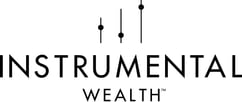INSTRUMENTAL WEALTH
Investment Strategies

Strategic Support for Financial Security
We believe true financial security comes from a meticulously crafted and continually managed investment strategy tailored to your distinct goals. As an independently owned Registered Investment Advisor (RIA),
we stand as fiduciaries, committed solely to your best interests.
This means we charge a transparent fee for our expertise, never commissions on investment products.
Our advice is free from conflicts of interest.
Through an open-architecture platform,
we diligently search for and integrate the best possible investments
to build a portfolio that truly suits your needs. This includes alternative investments such as privately held companies & real estate.

During regular portfolio reviews, you’ll have the opportunity to reassess your goals, discuss evolving market conditions, and fine-tune your portfolio accordingly.
Our Investment Process:
A Disciplined Approach to Your Wealth
Our robust investment process is designed to create, manage, and monitor portfolios that are aligned with your objectives and dynamically positioned for market opportunities.
Hover over a section of the SVG to see details here.
1. Strategic Asset Allocation: The Long-Term Vision
Our investment process begins with developing a strategic asset allocation, which forms the "big picture" long-term strategy of your portfolio. This involves:
- Long-Term Projections: For Cash Management Accounts (CMAs), we develop long-term projections for each asset class's expected returns, volatility, and correlations.
- Optimal Allocation: These CMAs are entered into our mean-variance optimization model to determine the optimal allocation for each asset class, identifying the most efficient risk/return profile for our models' specific risk categories.
- Market Alignment: This ensures your portfolios align with overarching market trends and our model's objectives over extended horizons.
2. Tactical Adjustments: Navigating Market Shifts
Complementing our strategic long-term approach, we employ tactical adjustments to address short to intermediate-term market shifts and macroeconomic conditions.
- Macroeconomic Insights: Drawing on our company’s macroeconomic insights, we strategically tilt asset classes and regional exposures to capture opportunities and mitigate emerging risks.
- Flexible Refinement: This flexible layer refines the strategic allocation in response to changing market dynamics.
3. Diversified Investable Universe
Once the broader allocation is determined, we move to investment selection. Our process spans a broad investable universe to tailor portfolios to each client's needs, optimizing for liquidity, diversification, and cost considerations. This includes:
- Individual stocks
- Open-end mutual funds
- Closed-end funds
- Individual bonds
- Exchange-traded funds (ETFs)
- Interval funds
- Alternative Assets: We also consider alternative assets to enhance diversification and potentially improve risk-adjusted returns. These can include:
- Private real estate
- Private equity
- Private credit
- Real assets We look beyond traditional stocks and bonds to define comprehensive investment solutions.
4. Rigorous Investment Research & Analysis
Our selection process begins with a robust analysis to evaluate potential investments, combining both quantitative and qualitative tools, and partnering with independent research firms.
Quantitative Analysis
We assess potential investments through a rigorous quantitative lens:
- Returns Analysis: We evaluate relative, absolute, and risk-adjusted performance against benchmarks, examining both recent (1-2 year) and longer-term (3, 5, & 10 year) results. We also assess consistency using rolling returns and calendar year returns.
- Peer Group Evaluation: We compare managers against their peers to gain insight into a fund’s performance and characteristics relative to others with a similar investment focus.
- Risk Analysis: We analyze various risk metrics including standard deviation, downside deviation, beta, batting averages, drawdown, and up/down capture ratios. These are compared against the benchmark and peer group.
- Expenses: Fee structures are carefully considered to maximize net returns for our clients.
- Assets Under Management (AUM): We analyze the total assets managed by a fund to understand its size and stability.
5. Rigorous Investment Research & Analysis
Our selection process begins with a robust analysis to evaluate potential investments, combining both quantitative and qualitative tools, and partnering with independent research firms.
Qualitative Analysis
In parallel, we conduct qualitative assessments of the management firm, the team running the fund, and their strategies:
- Investment Process Review: We evaluate the consistency and rigor of the investment process to ensure alignment with our philosophy.
- Firm and Personnel Review: The stability, tenure, and expertise of key personnel are vital indicators of consistent approach and performance.
- Portfolio Characteristics Analysis: We examine factors like holding concentration, turnover, active exposures, portfolio valuation, and profitability to determine overall soundness and sustainability.
- Portfolio Composition Analysis: We gauge diversification and evaluate any specific "bets" a fund is taking by examining market cap, style, sector, and regional exposures.
6. Dynamic Portfolio Construction
The final step is to construct portfolios by combining:
- Our strategic stance (long-term baseline)
- Macro views for tactical tilts (short to intermediate-term adjustments)
- Investment selections (from the evaluated investable universe)
This integrated approach ensures each portfolio is both well-diversified and dynamically positioned to respond to market opportunities.
7. Continuous Monitoring & Review
We continuously monitor and periodically review every portfolio, making adjustments as market conditions evolve or as your goals and risk profiles change. This ongoing process is critical to maintaining alignment with your objectives and optimizing performance outcomes over time. You will have 24/7 access to statements and regular performance reviews.Risk Mitigation Strategies
Our strategy for managing risk is implemented at two levels:
Asset Allocation Level
Diversification: One of the most effective ways to reduce risk is through diversification across asset classes. As the saying goes, "don't put all your eggs in one basket," and this is particularly true with investments.
Optimized Allocations: As we construct portfolios, we make projections on each asset class's returns and risk, as well as how they each correlate with each other. We then use a Mean-Variance Optimization (MVO) model that allows us to create overall allocations that aim to provide the best returns with the lowest volatility (risk).
Investment Level
In addition to broader risk control, we also individually examine each investment to ensure we are not taking outsized risks in the funds we select. Some key metrics we review are:
- For total risk in the fund: Standard deviation and downside deviation.
- For relative risk against a benchmark: Beta and up/downside capture ratios.
- For active risk against a benchmark: Information ratios, tracking error, and active share.
- For tail risk (extreme scenarios): Asset drawdowns, kurtosis, skewness, and value at risk.
